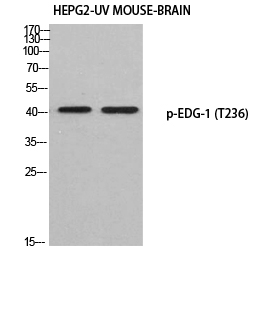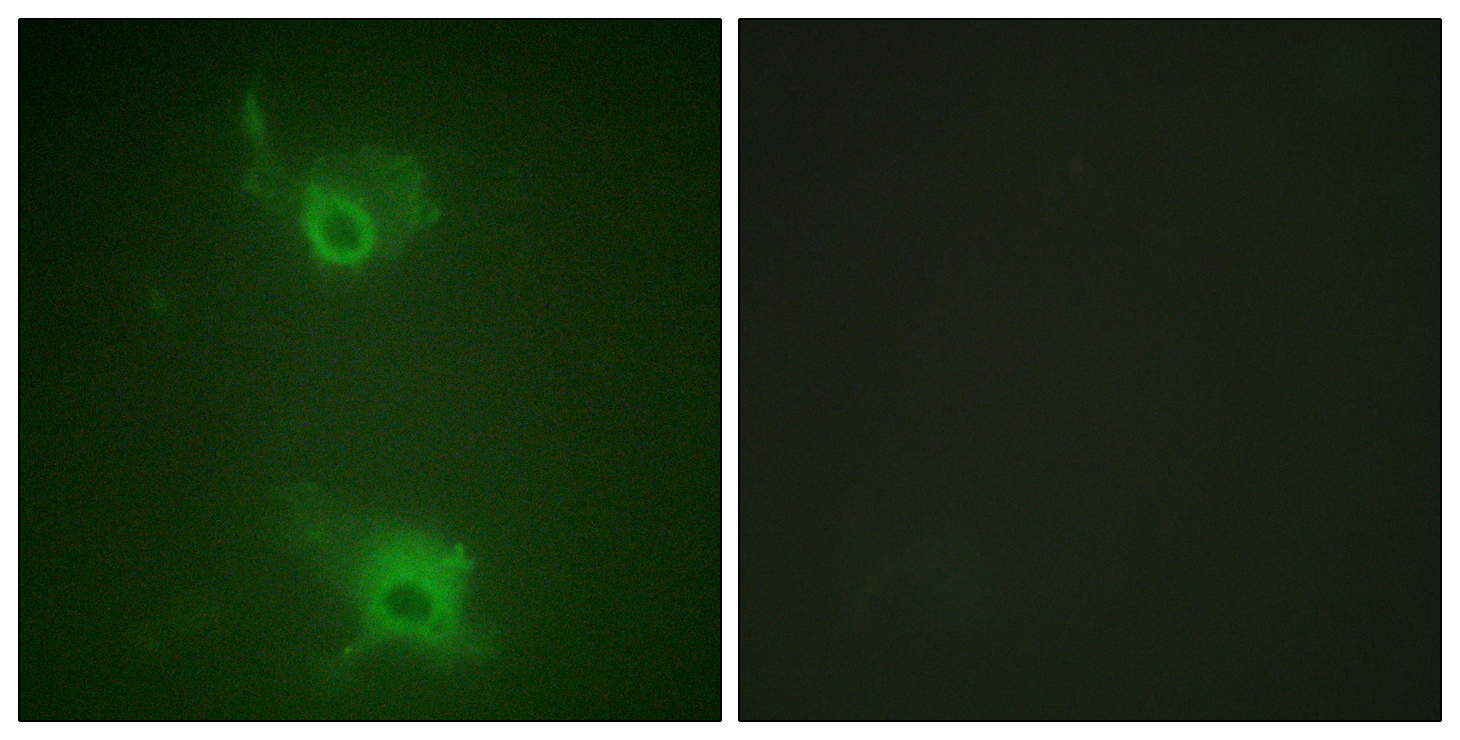EDG-1 (phospho Thr236) Polyclonal Antibody
- Catalog No.:YP1193
- Applications:WB;IF;ELISA
- Reactivity:Human;Mouse;Rat
- Target:
- EDG-1
- Fields:
- >>FoxO signaling pathway;>>Sphingolipid signaling pathway;>>Neuroactive ligand-receptor interaction
- Gene Name:
- S1PR1
- Protein Name:
- Sphingosine 1-phosphate receptor 1
- Human Gene Id:
- 1901
- Human Swiss Prot No:
- P21453
- Mouse Gene Id:
- 13609
- Mouse Swiss Prot No:
- O08530
- Rat Gene Id:
- 29733
- Rat Swiss Prot No:
- P48303
- Immunogen:
- The antiserum was produced against synthesized peptide derived from human S1P Receptor EDG1 around the phosphorylation site of Thr236. AA range:206-255
- Specificity:
- Phospho-EDG-1 (T236) Polyclonal Antibody detects endogenous levels of EDG-1 protein only when phosphorylated at T236.
- Formulation:
- Liquid in PBS containing 50% glycerol, 0.5% BSA and 0.02% sodium azide.
- Source:
- Polyclonal, Rabbit,IgG
- Dilution:
- WB 1:500-2000 IF 1:200 - 1:1000. ELISA: 1:10000. Not yet tested in other applications.
- Purification:
- The antibody was affinity-purified from rabbit antiserum by affinity-chromatography using epitope-specific immunogen.
- Concentration:
- 1 mg/ml
- Storage Stability:
- -15°C to -25°C/1 year(Do not lower than -25°C)
- Other Name:
- S1PR1;CHEDG1;EDG1;Sphingosine 1-phosphate receptor 1;S1P receptor 1;S1P1;Endothelial differentiation G-protein coupled receptor 1;Sphingosine 1-phosphate receptor Edg-1;S1P receptor Edg-1;CD antigen CD363
- Observed Band(KD):
- 42kD
- Background:
- The protein encoded by this gene is structurally similar to G protein-coupled receptors and is highly expressed in endothelial cells. It binds the ligand sphingosine-1-phosphate with high affinity and high specificity, and suggested to be involved in the processes that regulate the differentiation of endothelial cells. Activation of this receptor induces cell-cell adhesion. Alternative splicing results in multiple transcript variants. [provided by RefSeq, Mar 2016],
- Function:
- function:Receptor for the lysosphingolipid sphingosine 1-phosphate (S1P). S1P is a bioactive lysophospholipid that elicits diverse physiological effect on most types of cells and tissues. This inducible epithelial cell G-protein-coupled receptor may be involved in the processes that regulate the differentiation of endothelial cells. Seems to be coupled to the G(i) subclass of heteromeric G proteins.,induction:By the tumor promoter phorbol 12-myristate 13-acetate (PME) in the presence of cycloheximide.,PTM:S1P-induced endothelial cell migration requires the PKB/AKT1-mediated phosphorylation of the third intracellular loop at the Thr-236 residue.,similarity:Belongs to the G-protein coupled receptor 1 family.,tissue specificity:Endothelial cells, and to a lesser extent, in vascular smooth muscle cells, fibroblasts, melanocytes, and cells of epithelioid origin.,
- Subcellular Location:
- Cell membrane ; Multi-pass membrane protein. Endosome. Membrane raft. Recruited to caveolin-enriched plasma membrane microdomains in response to oxidized 1-palmitoyl-2-arachidonoyl-sn-glycero-3-phosphocholine. Ligand binding leads to receptor internalization.
- Expression:
- Endothelial cells, and to a lesser extent, in vascular smooth muscle cells, fibroblasts, melanocytes, and cells of epithelioid origin.
- June 19-2018
- WESTERN IMMUNOBLOTTING PROTOCOL
- June 19-2018
- IMMUNOHISTOCHEMISTRY-PARAFFIN PROTOCOL
- June 19-2018
- IMMUNOFLUORESCENCE PROTOCOL
- September 08-2020
- FLOW-CYTOMEYRT-PROTOCOL
- May 20-2022
- Cell-Based ELISA│解您多样本WB检测之困扰
- July 13-2018
- CELL-BASED-ELISA-PROTOCOL-FOR-ACETYL-PROTEIN
- July 13-2018
- CELL-BASED-ELISA-PROTOCOL-FOR-PHOSPHO-PROTEIN
- July 13-2018
- Antibody-FAQs
- Products Images

- Western blot analysis of HEPG2-UV MOUSE-BRAIN using p-EDG-1 (T236) antibody. Antibody was diluted at 1:500

- Enzyme-Linked Immunosorbent Assay (Phospho-ELISA) for Immunogen Phosphopeptide (Phospho-left) and Non-Phosphopeptide (Phospho-right), using S1P Receptor EDG1 (Phospho-Thr236) Antibody

- Immunofluorescence analysis of COS7 cells, using S1P Receptor EDG1 (Phospho-Thr236) Antibody. The picture on the right is blocked with the phospho peptide.



